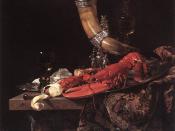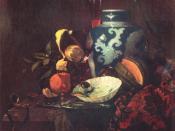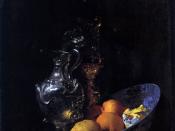Dutch art of the seventeenth century shows a preoccupation with domestic life and material objects. Focusing on two or three relevant paintings, discuss the significance of this preoccupation.
The still life paintings by Willem Kalf's 'Drinking Horn' and Abraham Van Berem's 'Banquet Still Life' paintings were produced during the enlightenment period of the 17th century, a Dutch Golden Age, in which the Dutch Republic was leading up to and establishing itself at the forefront of art, science and trade in Europe. This is particularly remarkable achievement as the Dutch had only become an independent state in 1579 and found itself locked in battle with Spain since 1586. Yet they still managed to illustrate culture through art, displaying their wealth, class and confidence. The strong moral message of the paintings is a result of Dutch Calvinism, which forbade religious art. Religious sentiment had to be represented with moral messages in still life paintings that became subtle as it developed through the vanitas theme and expressed its moral and religious sentiment via concealed symbolism.
The sins of pride and gluttony are clear in the paintings that are alluded to through morose undertones and heavy shadowing. The paintings of Kalf and Van Berem feature ostentatious representations of wealth, making them pronkstilleven (ostentatious still life), but this was not the glamorisaion of a lifestyle of luxury. These paintings provide a unique insight on disparate social classes, successful trade and attitudes toward wealth.
Willem Kalf's Drinking Horn was painted in 1653 and the painting features rich, bright colours but the sense of gloom persists, due to the fact that it is only the objects on the table that are illuminated. The dark background conveys a sense of emptiness, void of life and the chaotic placement of the objects creates a sense of unease...


